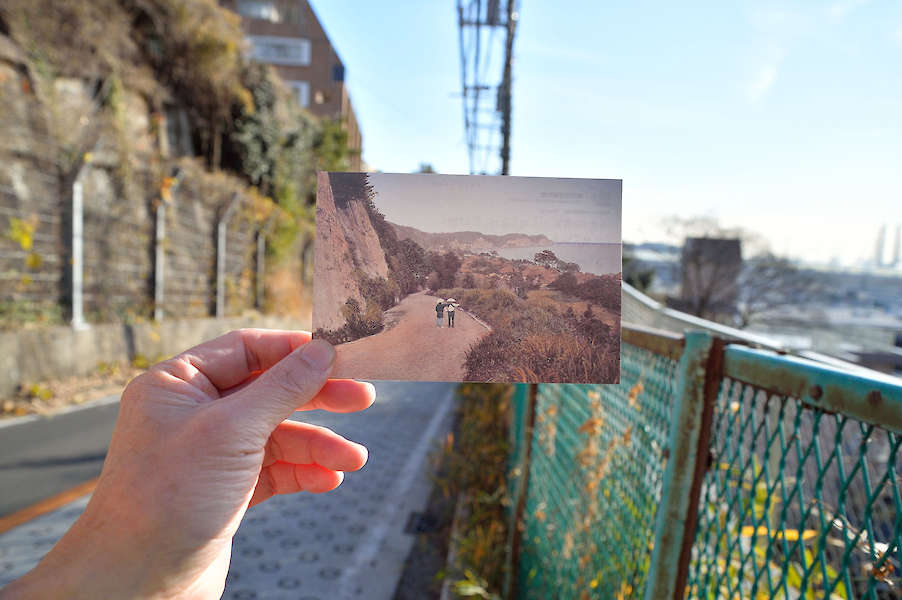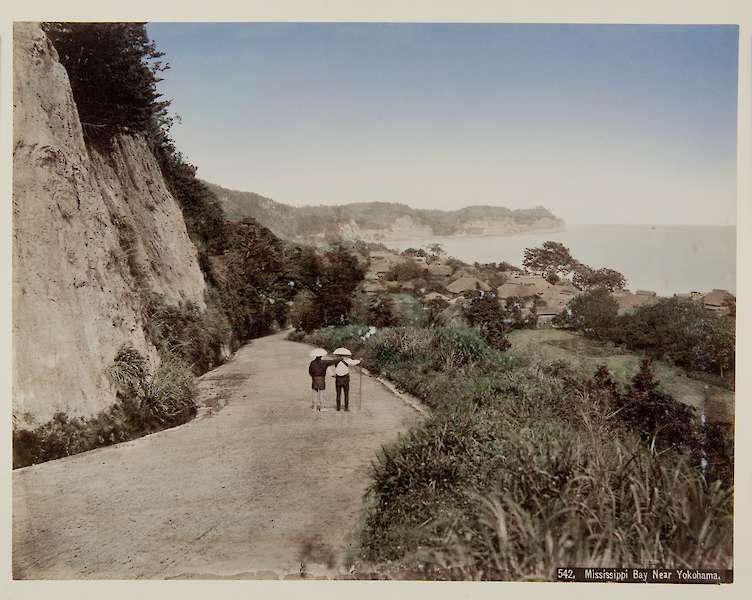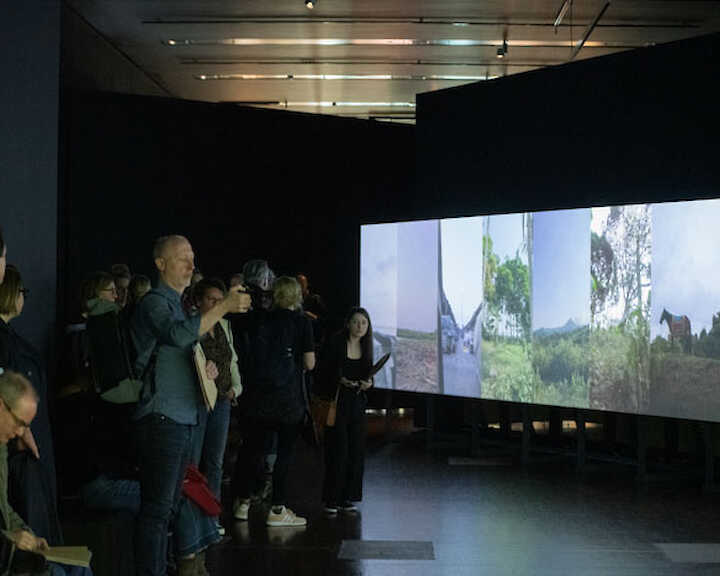Naoya Hatakeyama in dialogue with the students
of the M.A. program
"Photography Studies and Research"
Students: In deiner bisherigen Arbeit spielt das Archiv, so weit wir wissen, bislang wenn nur eine untergeordnete Rolle. Woher kommt nun das Interesse und was interessiert dich besonders an der Auseinandersetzung mit dem Archiv? - As far as we know, the archive has played only a minor role in your work so far. Where does this interest come from and what interests you in particular about the archive?
Naoya Hatakeyama: I am a photographer so I am interested in producing new images, but before taking photographs I should do "look" and "think". For doing this, I am using my own memory. My memory is built by my surrounding, my past and words by people around me, each are interpreted in my own way, then it's built inside my head. It's a great learning process, that is, getting meaning out of the informations. For me archive is a symbol of this process.
In an archive, there are no curators, the people whose task it is to pass judgement on the significance and value of the objects in storage, for example in a museum or art gallery. It is not the people of the present, but the people of the future who will find the significance and value of the documents in the files. Supported by such hopes and responsibilities, everything is carefully stored. Whether it is useful or remains in dead storage depends on who appears in the future. That person may not appear forever, though.
The archive is also like a great graveyard. When you put yourself there, you strongly feel the presence of people who are no longer with us, but who certainly were in this world. There, doubts about the past disappear.
Students: Du arbeitest zusammen mit dem Museum für ostasiatische Kunst, welches eine umfangreiche Sammlung an Fotografien hat. Wie war dein erster Eindruck beim Sichten des Bestandes und hat sich dieser mit der Zeit verändert? - You work together with the Museum of East Asian Art (MOK), which has an extensive collection of photographs. What was your first impression when viewing the collection and has it changed over time?
Naoya Hatakeyama: I have learned so many new things from their collection, and the people who work in the museum understand this learning process very well. They smile and watch me carefully, as I am pulling out new meaning from their collection. To think about the difference of "collection" and "archive" is another important thing.
The photographs in the MOK archive were taken for catalogue purposes or as copies for printing -- in other words, they are reproductions of the original art works and do not directly affect our sensibility and thought.
On the other hand, the MOK has a large collection of photographs collected by its founder, Adolf Fischer, in various parts of Asia at the end of the 19th century. Needless to say, these are not in the archive cabinet.
The purpose of Fischer's numerous trips to East Asia was, of course, to research and collect paintings, sculptures and other works of art in each country. Paintings and sculptures can be acquired and brought back to Europe. However, there are some things in the world that are as beautiful as paintings and sculptures, but
cannot be taken back home, such as architecture and landscapes. What did he bring back instead? It was copies of those, called photographs.
Students: Hat sich deine Arbeitsweise aus dem Material in dem Archiv heraus entwickelt? Oder war dir vorher schon bewusst, wie du arbeiten möchtest? - Did your working method evolve from the material in the archive? Or were you already aware of how you wanted to work beforehand?
Naoya Hatakeyama: I frankly had no idea before I came to Germany. I didn’t know, what I will find before I was actually browsing through the archive.
“When finding a gem in the desert, the more extensive the desert, the more valuable the gem will be. In the same way, the 'many others' files can be said to boost the value of the one useful file by its sheer number.”
Students: Wie wir bereits erfahren konnten, begegnest du den Orten aus den Fotografien wieder und unterziehst sie deinem fotografischen Blick aus dem Jetzt heraus. Welche Orte sind es die dich für dieses Projekt interessieren?
Recherchierst du die auf den Fotografien abgebildeten Orte im Vorfeld bereits oder spielt ein Moment von Überraschung, wenn du dich an sie begibst, eine Rolle? - As we have already come to know, you re-encounter the places from the photographs and subject them to your photographic gaze from the now. What are the places that interest you in this project? Do you research the places depicted in the photographs beforehand or does a certain moment of surprise play a role when you go to them?
Naoya Hatakeyama: I came to recognize myself as "Japanese" and gained a concrete understanding of the rich history of cultural exchange between Japan and Europe. It was a stroke of good fortune that brought me this realization.
While the term "photographer" may be simplified as one who takes photographs, there is a deeper purpose behind their work. It all begins with the act of "looking."
"Looking" is the process of translating visual information into meaningful insights. For photographers, this ability to "look" is honed through the physical experience of taking and examining their own photographs, as well as through studying the work of others. This dialectical process forms a unique expertise in the art of "looking."
Students: In deinem eigenen Werk ist der Aspekt der Zeit von besonderer Bedeutung. Welche Rolle spielt Zeitlichkeit in deiner Auseinandersetzung mit dem Archiv des MOK? - In your own work, the aspect of time is of particular importance. What role does temporality play in your engagement with the MOK archive?
Naoya Hatakeyama: By looking at photographs, I can learn about temporality in a way that I would not experience through my daily life. Thanks to photographs, the time of my own life is completed. Its meaning becomes greater for me and it has become a pure concept that still holds a deep mystery.
Students: Ist die Arbeit mit dem Archiv etwas, was dich über deine Beschäftigung im Rahmen des AMA-Programms hinaus interessieren könnte? - Is working with the archive something that might interest you beyond your involvement in the AMA program?
Naoya Hatakeyama: It really is a hard job, to look carefully at numerous images done by somebody else. Frankly, it exhausts me. Of course looking at photographs in the archive is very interesting and inspiring. But I think that all photo-practicians are interested in creating their own photogtaphs, which can be more interesting and inspiring. Now I strongly feel like going out with my camera and tripod. Moreover, it's sunny and warm here in Tokyo today. Spring has come.
This Interview was carried by: Oliver Heise, Martin Ruckert, Jan Steuer, Tobias Nielsen
Naoya Hatakeyma's exhibition at the Photoszene-Festival 2023






